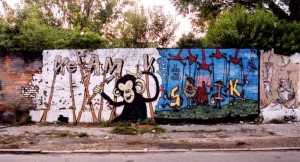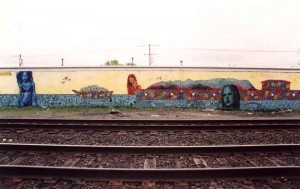Graffiti is a medium that affords visibility; it is supposed to be seen. When New Yorkers in the 1970’s began to create the art form that would spread throughout the world, they covered the subway carriages so their names could be taken from one end of the city to another. When the subways were cleaned and made graffiti-free in the late 1980’s, graffiti writers moved their passion to the busiest streets they could find.
The growth of graffiti media was natural; graffiti’s ephemeral nature all but required its practitioners to become photographers who documented their own work. And since they had some extra film on the roll, they’d shoot the work of their buddies and heroes, too. Many photo-processing shops offered a free second set of prints, which allowed graffiti photos to be traded among friends and sent across the country or the world.
Eventually, someone had enough photos to fill a magazine (perhaps also a buddy who worked at a printing and copy shop who would let them in while the boss wasn’t looking) and graffiti magazines were born. By the early 1990’s, when desktop publishing software became prevalent, the number of graffiti magazines exploded, with writers from the United States, Europe, Australia and beyond, all making small-budget fanzines to the best of their abilities.
One such magazine was 12 Oz. Prophet, which began in 1993 as a project from a Rhode Island School of Design student, Allen Benedikt. It fast established itself in the graffiti community initially because of its high production values and slick look, and later, with some longer-form articles about graffiti from various places (full disclosure: that was me writing the articles from Brazil). By the late 1990’s, the Internet was ubiquitous, and print seemed difficult to maintain as a news-breaker, whether in graffiti or in mainstream journalism. Allen Benedikt turned his efforts to 12ozprophet.com and especially to its “Writers’ Forum,” where graffiti enthusiasts could network, post images, talk trash, and see work from all over the globe, in many cases immediately after it was painted. Graffiti writers now routinely use www.12ozprophet.com as a networking tool – before a trip to Europe, an American graffiti writer might reach out to a European graffiti writer in order to meet up and paint together. Exhibition curators and project organizers also use the forum to trawl for new talent.
To call the 12ozprophet.com Writers’ Forum popular is an understatement. For example, in terms of it’s traffic, it is busier than any single forum dedicated to some of the most popular sports in America, such as Baseball or Gridiron (Football). While the big money available in sport certainly eludes graffiti writers, there does appear to be a broader audience than many ever imagined, and, as graffiti writers see it, the technology of the online forum has changed graffiti itself in several ways.
Here are some common sentiments – both about graffiti on the Internet (for better or for worse), as well as its most popular outlet, the 12ozprophet.com Writers’ Forum:
“The biggest negative effect of the Internet on graffiti seems to be the destruction of regional styles and regional techniques. Graffiti is very closely linked with the city you live in and I see all these kids trying to pull off L.A. styles in Washington D.C. or whatever…it doesn’t look good, it doesn’t make sense in that context and it’s disrespectful to your own city’s history as well.” – Mpower, Chicago
“The introduction or the accessibility of technology has changed graffiti more than anything… The major down side is that, unlike traveling, you are limited in your ability to wander, to discover or dwell on graffiti that draws your attention. Instead, whoever has the ability to post pictures, will direct your virtual path through the city. In other words, there is often a major discrepancy between what objectively is “up” and what is posted on the Internet the most.” – Kept, Oakland, California
“Just because of my geographical position (Athens, Greece), a small country that was never in the graffiti map, I understand that this change of scale could be a lot more harmful for others, but it also gives me an understanding of how more updated one can be by using the internet and what amount of knowledge it can bring so easily.” – Naze, Athens, Greece
Graffiti – like any other handmade and recondite culture – inspires mixed feelings when it experiences an injection of technology, especially since graffiti sprung from the efforts of a resourceful and far from wealthy group of young people. Broadly speaking, graffiti’s tremendous presence on the Internet has upped the movement’s collective self-awareness by presenting both its history and its cutting edge. And what’s especially compelling is that the most vocal graffiti Luddites are often online themselves, seeing the teachable moments and constantly reminding their peers to close their browsers and explore their surroundings for themselves.
Caleb Neelon
Caleb Neelon is an artist, writer, and educator. His paintings, installations and murals have appeared in solo, group shows and as murals across America and Europe. He is co-author of the Thames and Hudson books Graffiti Brasil and Street World. He is an editor at the popular culture hardbound bi-monthly Swindle, and has been a contributing writer to Tokion, Print, Juxtapoz, On The Go and Lemon.
Read More
http://www.theartwheredreamscometrue.com
http://www.12ozprophet.com/forum/
Watch More
Group show featuring Caleb Neelon and Mike Shine at White Walls Gallery.
 This work is licensed under a Creative Commons Attribution-NonCommercial-NoDerivs 2.5 Australia.
This work is licensed under a Creative Commons Attribution-NonCommercial-NoDerivs 2.5 Australia.








